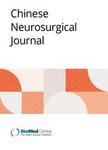A new scoring system for predicting extent of resection in medial sphenoid wing meningiomas based on three-dimensional multimodality fusion imaging
A new scoring system for predicting extent of resection in medial sphenoid wing meningiomas based on three-dimensional multimodality fusion imaging作者机构:Department of Neurosurgery The First Affiliated Hospital of Soochow University 188 Shizi Street Suzhou 215006 Jiangsu Province China Department of Orthopedics Department of Radiology Suzhou Hospital of Traditional Chinese Medicine
出 版 物:《中华神经外科杂志(英文)》 (Chinese Neurosurgical Journal)
年 卷 期:2021年第07卷第1期
页 面:43-52页
核心收录:
学科分类:1002[医学-临床医学] 1001[医学-基础医学(可授医学、理学学位)] 100214[医学-肿瘤学] 1009[医学-特种医学] 10[医学]
基 金:This work was supported by the Suzhou Health Talents Training Project(GSWS2019002)
主 题:Brain tumor Sphenoid wing meningioma Scoring system Fusion imaging 3D reconstruction
摘 要:Background: Three-dimensional (3D) fusion imaging has been proved to be a promising neurosurgical tool for presurgical evaluation of tumor removal. We aim to develop a scoring system based on this new tool to predict the resection grade of medial sphenoid wing meningiomas (mSWM) ***: We included 46 patients treated for mSWM from 2014 to 2019 to evaluate their tumors location, volume, cavernous sinus involvement, vascular encasement, and bone invasion by 3D multimodality fusion imaging. A scoring system based on the significant parameters detected by statistical analysis was created and ***: The tumor volumes ranged from 0.8 cm3 to 171.9 cm3. A total of 39 (84.8%) patients had arterial involvement. Cavernous sinus (CS) involvement was observed in 23 patients (50.0%) and bone invasion was noted in 10 patients (21.7%). Simpson I resection was achieved in 10 patients (21.7%) and Simpson II resection was achieved in 17 patients (37.0%). Fifteen patients (32.6%) underwent Simpson III resection and 4 patients (8.7%) underwent Simpson IV resections. A scoring system was created. The score ranged from 1 to 10 and the mean score of our patients was 5.3 ± 2.8. Strong positive monotonic correlation existed between the score and resection grade (Rs = 0.772,P 0.001). The scoring system had good predictive capacity with an accuracy of 69.60%.Conclusions: We described a scoring system that enabled neurosurgeons to predict extent of resection and outcomes for mSWM preoperatively with 3D multimodality fusion *** registration: Retrospectively registered



